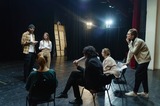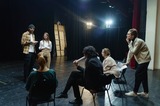
Encourage your students to creatively explore character building through practicing the 8 Efforts of Laban!
- Subject:
- Dance
- Fine Arts
- Physical Education
- Theater
- Material Type:
- Activity/Lab
- Interactive
- Author:
- Lorin Mello
- Date Added:
- 07/27/2022

Encourage your students to creatively explore character building through practicing the 8 Efforts of Laban!

A clear outline for student expectations during rehearsals, class, tech week, and/or production days.Keep them focused and accountable and modify to fit the needs of your program.Can be used for class syllabus or after school/in class productions.

Explore how writers use storyboards to visualize books and movies, learn how actors train and use fight choreography to portray stories on stage, and become a work of art yourself on this episode of The Creative Corner. Everyone loves a good story.

Audition Form Template for teachers or directors to modify for class or after school productions.

Allow students the opportunity to explore their career goals! This activity will allow them to develop their research skills and provide a hands-on experience to help stretch their perspective. Let your students guide themselves into discovering new career path options!

Have students learn about the main characters in William Shakespeare's Hamlet. Let THEM become the casting director as they decide who is best fit to play the part!

Engage students in a discussion about the definition of failure and why so many people are afraid of it using Theodore Roosevelt's Man in the Arena speech from 1910.

This document contains a sample list of fine arts careers by discipline, links and resources for exploring fine arts careers, and resources for workbased learning in fine arts courses.

Students will learn historical facts about William Shakespeare and apply those facts to hip hop music/spoken word. Students will identify contemporary grammar and vocabulary influenced by Shakespeare. Students will create an original spoken word expressional/rap final performance.

Digital Media is a growing artistic element in Theatre Production. This unit covers common film/media terminology, introduces the career field of the theatrical digital media director, provides instruction on best practices for filming using cell phones or a laptop, introduces editing strategies, and culminates in a creative product by the student.

Students will create and perform scenes using tableaux in order to further understand acting techniques, physical techniques, character development, and theatrical direction.

Students learn communication and collaboration skills for theatre with improvisation games. Once games are learned and practiced, improvisation teams are formed and opportunities are given for students to perform for a live audience.

Students will learn basic acting and improvisation skills through different activities. Students will be able to identify and use learned acting techniques during improvisation games through imaginative play.

Students will learn the common parts of any lighting instrument and which instruments are most appropriate for achieving certain lighting effects. This lesson covers traditional incandescent lighting instruments, not LED instruments.

Students will be introduced to different aspects of theatre design and collaborate in groups as production teams. Each team will create and present a theme statement, a production concept, mood board(s), and basic technical designs for a work of dramatic literature. This unit could also be adjusted to work as a culminating activity for the course.

Students will understand that information passes from generation to generation through the ancient tradition of storytelling. Students will recognize that puppetry is a visual expression of storytelling used by many cultures for entertainment, community gatherings, to convey information and to encourage understanding and/or empathy. Students will create a shadow puppet and perform a short puppet show based on a folk tale, tall tale, or poem.

This lesson focuses on identifying and discussing the symbolism used in theatrical works. The culmination of the lesson is applying symbolism to a devised performance piece.

One of the most important functions of sound design is sound amplification. In this lesson, students will learn about basic audio equipment, to include cables, microphones, and the sound system. Students will also demonstrate how to set up a simple sound system.

Understanding intellectual property and copyright is crucial to theatre practitioners, be they actors, technicians, directors, or managers. Students will research terms and identify cases of copyright infringement in the theatre arts.

This unit utilizes readily available gaming technology to teach and reinforce principles of theatrical set design. Students will create an original set design using computer gaming applications involving building tools.